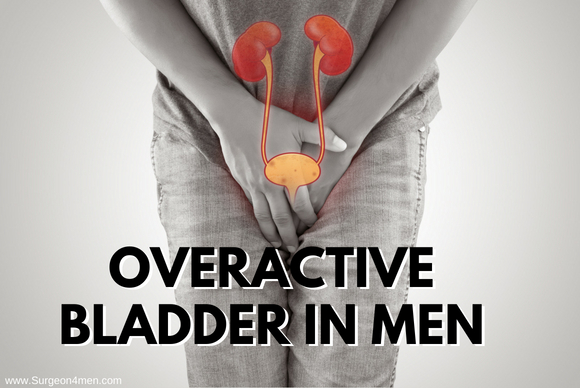Overactive Bladder In Men
Overactive bladder is categorized under urinary tract disorders; it is common in both males and females. There are various sign and symptoms associated with this syndrome; such as:
- Affected person feels sudden uncontrollable urge to urinate
- There are often episodes of involuntary urinary leakage, which is known as urine incontinence
- The individual often feels the need to visit the bathroom several times a day.
In poorly managed cases, this condition can adversely impact the person’s life
Statistics:
Approximately 33 million people in US suffer from urinary complaints of which 30% males and 40% female have OAD symptoms. The exact number of people who are suffering from this condition is still not known as a lot of people are too ashamed or embarrassed to seek medical help for their troubling symptoms
Causes of Overactive Bladder in Men:
The primary cause of overactive disorder is uncontainable contraction or spasm in the wall of bladder which result in sudden urge to pee. This contraction is involuntary and occurs even with low volume of urine in the bladder. The risk of developing OAB increases with increasing age.
Another cause of OAB is enlarged prostate gland. As you age, your prostate gland expands and obstructs the normal flow of urine that results in OAB. The National Association For Continence declared that approximately 50% of the men develop symptomatic enlargement of prostate gland by the age of 60.
Some abnormalities within the nervous system can also causes OAB such as:
- Injury in the spinal cord
- Hernia
- Strokes
- Parkinson disease
- Dementia
- Multiple sclerosis.
There are many other factors that can contribute to the occurrence of OAB.
- Certain medication that increase urination.
- Obesity
- Diet
- Constipation
- Urinary tract infection
- Bladder infection
- Stones in bladder
- Mobility issues
- Diminish cognitive function.
- Excessive alcohol consumption.
Diagnosis:
Doctor recommend a comprehensive physical exam after obtaining a detailed history of urinary tract symptoms or if you are undergoing any symptoms of overactive bladder.
Your doctor will also collect your urine sample in order to assess any infection or presence of stones. There are also numerous tests available for the evaluation of OAB these are
- Sphincter exam
- Rectal exam to check prostate gland.
- Neurological exam.
Based on the result of these test doctor will recommend treatment.
TREATMENT
There are various ways to treat OAB.
Lifestyle changes:
Unhealthy lifestyle may lead to the symptoms of OAB. By modifying our lifestyle choices, we may alleviate these symptoms.
-
Diet:
There are various foods that may further worsen the symptoms of OAB. Healthy diet is most important for healthy bladder functioning.
-
- Reduce caffeine intake
- Reduce alcohol consumption.
- Avoid artificial sweeteners
- Quit smoking
- Cranberry juice as it acts as a diuretic
- Avoid acidic foods & carbonated drinks.
-
Exercise:
There are different exercises that are recommended to OAB patients like pelvic floor strengthening exercises. It is better to workout on an empty bladder.
-
Bladder training:
The frequent uncontrollable urge to pee is due to contraction of bladder muscle. You should train the bladder so that it will contract only when it is full.
-
Reduce weigh:
Weight gain and obesity is major issue which increases the OAB symptoms. Excess weight causes excess pressure on the urethra which in turn worsens the symptoms. To treat OAB, it is necessary to reduce weight.
Medications:
If you are unable to control OAB symptoms with life style changes, your doctor will recommend you to take alpha blockers that helps in comforting the muscles around the bladder and improves the flow of urine. Following medicines are prescribed.
- Antimuscarinics.
- 5 alpha reductase inhibitors.
- Anticholinergics.
Nerve stimulation:
If OAB is due to nerves disorders then nerve send improper signals to bladder. In order to regulate these signals, nerve stimulation is advised. In this procedure a small device is placed under your skin near your tailbone. This device is then use to pass small amount of current to the muscles that engages in urination. This current helps in regulating the contraction. The device can be removed after treatment.
Surgery:
If your OAB symptoms are uncontrollable and severe then doctor may recommend surgery. For example, if your symptoms are due to enlarged prostate then part of gland is removed through surgery.
Outlook:
The occurrence of OAB is quite common among males particularly when as they get older. It is recommended to consult your doctor immediately if you feel any of these symptoms rather than feeling embarrassed or ashamed.

